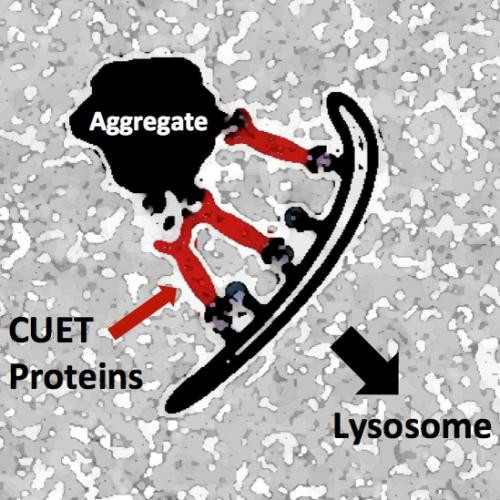 |
|
蛋白质是我们身体中的重要组成部分,它们执行、控制细胞基本上所有的功能。蛋白由氨基酸组成,根据其所需功能折叠成特定的和复杂的三维结构。 然而,因为蛋白折叠和结构的维持对于细胞应激或环境应激是高度敏感的,蛋白有发生错误折叠或形成团块(聚集体)的潜在可能性。 这种不期望的蛋白折叠对细胞具有毒性,甚至可能导致细胞死亡。因为一些人的神经变性疾病已知与异常蛋白聚集体的堆积相关,基础科学旨在了解细胞是如何去除细胞垃圾(错误折叠蛋白或异常蛋白聚集)的,而这是设计策略以潜在预防或治愈这种疾病的基础。 MPIB Stefan Jentsch实验室科学家现已成功应用面包酵母筛选新的细胞废物处置途径。来自中国的博士后研究员Kefeng Lu发现了一类新的辅助蛋白(称为CUET蛋白质)同时存在于酵母和人类中,以类似泛素降解蛋白的方式,能识别并标记细胞垃圾。 重要的是,这些新鉴定的辅助蛋白通过一个自食(self-eating)通路(自噬)将细胞垃圾导至溶酶体中,后者是细胞专门用于销毁和回收细胞垃圾的区域。 Max Planck科学家也表明,与神经退行性疾病--亨廷顿氏病相关的异常,聚集的一种有毒蛋白质“亨廷顿”,可有效地被新发现的垃圾处置途径摧毁。值得注意的是,这条途径似乎特异性的针对凝集蛋白如亨廷顿蛋白,同时可能比以前发现的细胞垃圾处理机制更有效。 因为发现细胞处理垃圾机制也在酵母中运作,后续研究将充分利用酵母强大的实验可行性,进一步调查这个细胞垃圾处理途径。这一机制的详细分析,对于理解聚集形成的蛋白质如何导致人类疾病,并开发新的策略来对疾病进行防治将是至关重要的。 详细英文报导: A new cellular garbage control pathway with relevance for human neurodegenerative diseases Proteins, the components of our body that execute, control and organize basically all functions in our cells, are made out of strings of amino acids, which – like an origami - are folded into specific and complex three-dimensional structures according to their desired functions. However, since folding and maintaining of such structures is highly sensitive to cellular or environmental stress, proteins can potentially misfold or form clumps (aggregates). Such undesired protein waste can be toxic for cells and may even lead to cell death. Because several human neurodegenerative diseases are known to be linked to an accumulation of abnormal protein aggregates, basic science aimed to understand how cells remove cellular garbage is elementary for designing strategies for a potential prevention or cure of such disorders. Scientists in the laboratory of Stefan Jentsch at the MPIB now successfully used baker's yeast for screening for new cellular waste disposal pathways. Kefeng Lu, a postdoctoral researcher from China, discovered a new class of helper proteins (termed CUET proteins) present both in yeast and humans that recognize cellular garbage earmarked for disposal by an attached label in the form of the ubiquitously existing protein known as "ubiquitin". Importantly, these newly identified helper proteins channel the cellular garbage by a "self-eating" pathway (autophagy) to the lysosome, a compartment of cells dedicated for destruction and recycling. The Max Planck scientists could also show that a toxic protein related to the abnormal, aggregate-forming protein "huntingtin" of patients with the neurodegenerative Huntington's disease is efficiently destroyed by the newly identified pathway. Remarkably, this pathway seems specific for aggregated proteins like huntingtin and appears to be more potent than previously discovered cellular garbage disposal mechanisms. Because the identified cellular disposal mechanism operates in yeast as well, the researches will now take full advantage of its powerful experimental possibilities to investigate this pathway further. A detailed analysis of this mechanism will be crucial to understand how aggregate-forming proteins lead to human diseases and may help to develop concepts for possible disease preventions. |
细胞处理“垃圾”的新途径
时间:2014-07-22 21:33来源:生物谷 作者:未知
顶一下
(0)
0%
踩一下
(0)
0%
------分隔线----------------------------
- 上一篇:李克强:通过改革允许科技人员持有股权期权
- 下一篇:孕期营养不良影响止于孙辈
- 发表评论
-
- 最新评论 进入详细评论页>>
- 推荐内容
-
- 近五年毒理学研究机构的研究论文
5 印度的研究机构比较 在印度的研究机构(表 5 )中,印度科学...
- 美国出台BRAIN计划伦理问题报告
美国生物伦理问题研究总统委员会近日发布了首个报告 —— 将...
- 高胆固醇或致怀孕难
对某些怀孕困难的夫妇来说,问题也许与其胆固醇水平高有关。...
- 生命科学研究评价的新指标
文献计量学是以文献体系和文献计量特征为研究对象,采用数学...
- 脑科学计划何去何从?
题名: Whereto the mega brain projects? 作者: Mu-ming Poo 单位: Instit...
- 生物学标志记录岁月的痕迹
你知道自己衰老的速度如何么? 先别忙着去偷看网上“生物年龄...
- 近五年毒理学研究机构的研究论文
